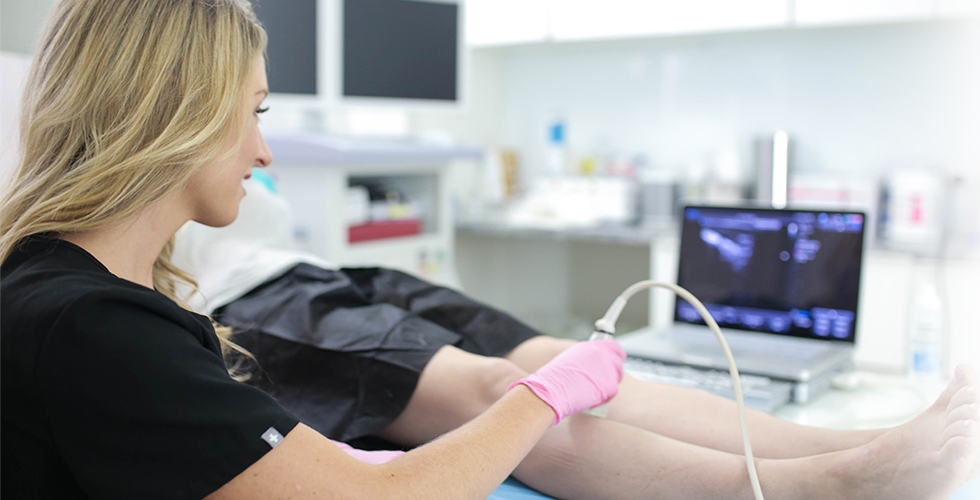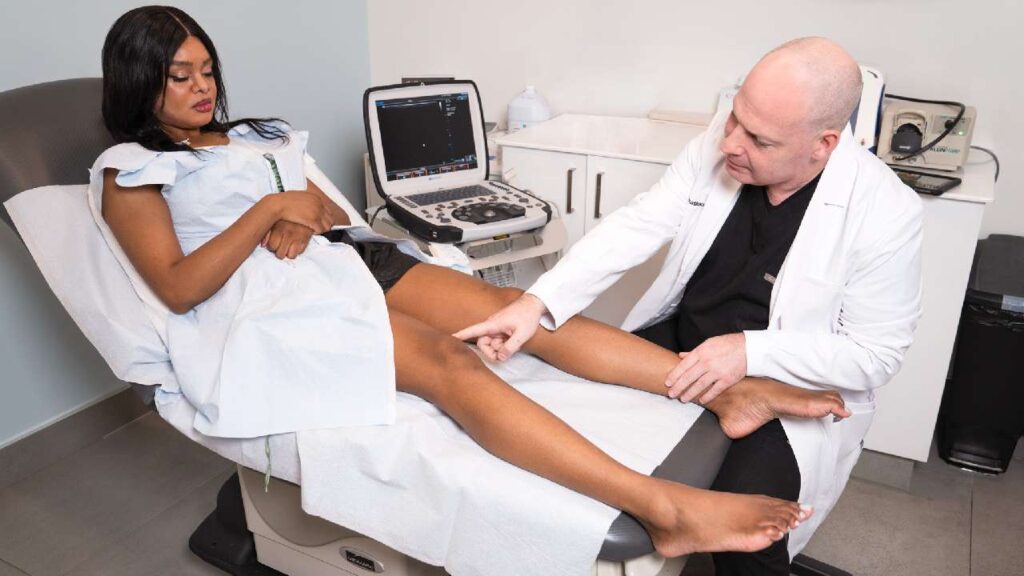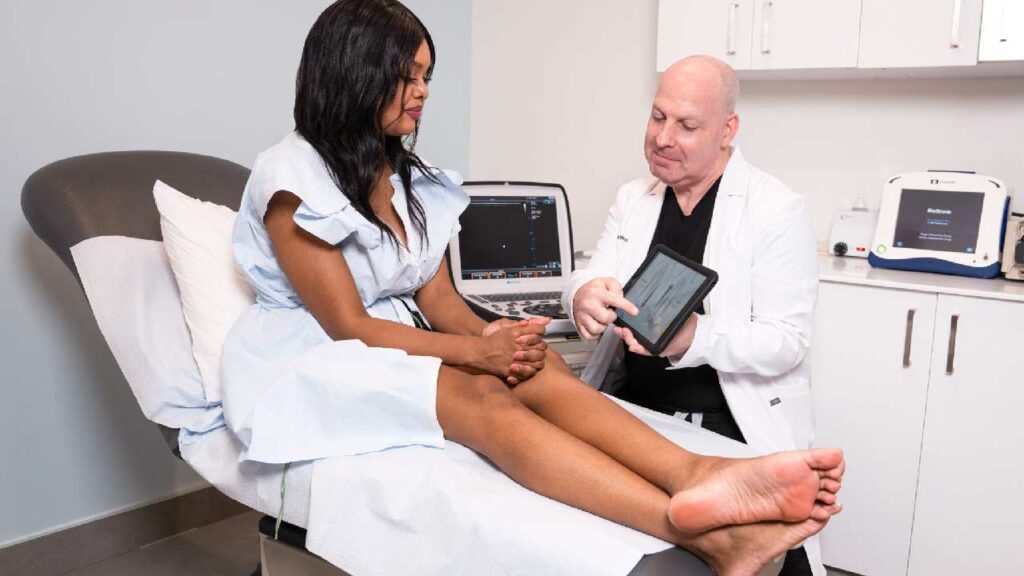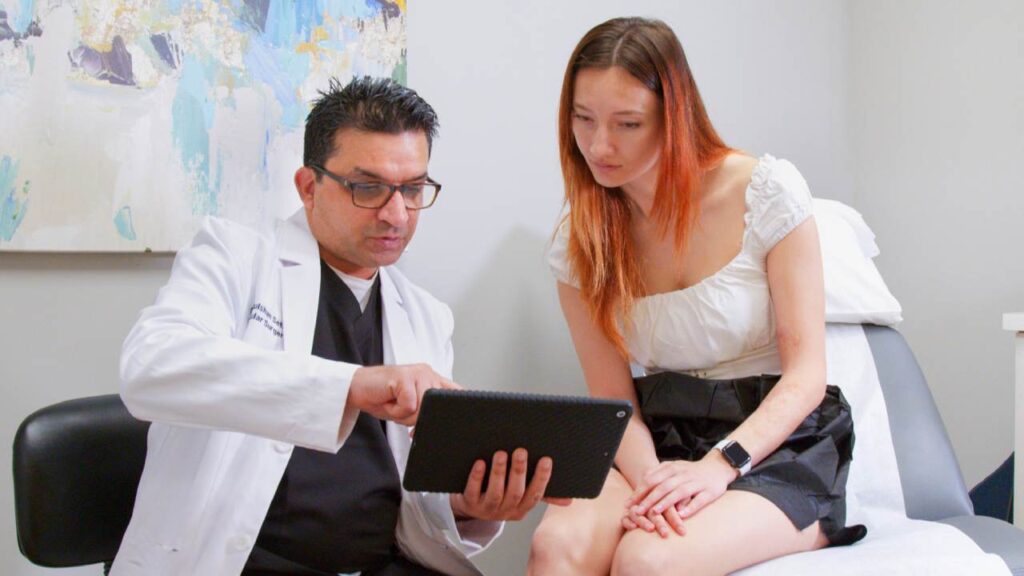How Can I Ease Painful, Gnarled Veins at Home?
Varicose veins can cause swelling, pain, cramping, restlessness, heaviness, and itching in your legs. That’s because they often stem from compromised circulation. When a valve fails in a vein, blood leaks backward, rather than continuing toward the heart. This builds pressure that generates a swollen, twisted varicose vein. It also causes those unpleasant symptoms.
Broken valves can also produce spider veins and more advanced symptoms like venous ulcerations, profuse bleeding, venous stasis dermatitis, and hyperpigmentation. If you have painful varicose veins, the best choice is to have them assessed. Book an appointment with Harvard-trained vein doctors to learn about varicose veins treatment that corrects these problems in under 30 minutes. Here’s how to ease painful varicose veins until your appointment.
- Elevate your legs while resting: For best results, prop your feet above heart level while you sleep. This helps blood to flow upward, rather than pooling in your legs. You can also put your legs up while seated, especially if you work on your feet all day.
- Wear compression stockings if your vein doctor approves: These need to be the right size, so ask your vein doctor for a recommendation. Some patients get symptom relief from compression stockings, but others have no benefit, and certain patients should not wear them. Compression and constriction are different. Avoid clothing with tight waistbands, tight socks, and tight shoes to improve blood flow.
- Change positions every 30 minutes: If you sit or stand for long periods of time, blood accumulates in faulty veins. Flex your calf muscles and stretch your legs when you have to remain in place. And change positions several times a day. Contractions in the calf muscles help pump blood out of your veins.
- Exercise and maintain a healthy weight: Varicose veins are common, even if you aren’t overweight. But extra weight places more pressure on veins in your legs and pelvic region. That’s why varicose veins are common during pregnancy, in conjunction with hormone shifts and extra blood volume while pregnant. Walking, cycling, swimming, and exercises that stretch your legs ease painful varicose veins.
- Cool Down to Reduce Pain and Discomfort: Some types of pain feel better when we apply heat. But for many people, varicose veins feel worse. Heat increases heart rate and blood pressure, which causes veins to swell. After a hot workout, a long shower, or a day in the sun, many people notice their varicose veins bulging more. Try a cool shower or soak the affected area in cool water. Or apply a cool compress and stay in the air conditioning to reduce swelling and pain.

What Symptoms Mean It’s Time to Go to the Vein Doctor?
The steps above can help reduce symptoms. However, they can’t erase varicose veins or Chronic Venous Insufficiency. Most patients will need varicose vein treatment if they want the vein to disappear. The best course of action is to see a vein doctor as soon as possible, to prevent complications like blood clots, heavy bleeding, slow-healing ulcerations, and permanent discoloration.
If you have an area of the skin that suddenly becomes red, warm, or tender, head to the emergency room. This might be a blood clot. Likewise, go to the ER if you have chest pain, shortness of breath, or lightheadedness, to make sure a blood clot hasn’t broken loose and traveled to your lungs. If you have bleeding that you can’t control, you should also seek urgent care.
These symptoms aren’t as urgent, but they indicate that you need to see a doctor. Heavy bleeding that stops fairly soon, discoloration on legs, an itchy rash above your vein, or slow-healing wounds. If you have painful, swollen legs, you might be on your way to developing these serious symptoms, so see a vein doctor soon.
Which Specialist Treats Varicose Veins in New York?
The best specialist for varicose veins is a minimally invasive vein doctor. These physicians treat veins without surgery, but they go more than skin deep. They use tiny needles to administer treatment directly to the vein, rather than surgically extracting it. For most varicose veins, this is the ideal level of intervention.
Do Certain Symptoms Determine What Doctor to See for Veins?
What causes varicose veins also causes spider veins. But these blood vessels have a different presentation. Spider veins are small and often develop in clusters. Varicose veins are larger, protrusive, and often singular. Both look twisted, and both can have the unpleasant symptoms we’ve described.
A facial spider vein might respond to surface treatments at a dermatologist. But veins in the legs usually stem from Chronic Venous Insufficiency, which requires a vein doctor’s technology. No matter where your veins are located, a vein doctor is the best choice. They use ultrasound-guided treatment devices, which is how to ease painful varicose veins for good.
How Do I Prepare for My Vein Consult?
Before your vein consult, you’ll tell our team what insurance you have, so they can secure your coverage. On the day of your consultation, wear loose clothing so the vein doctor can take a look at your blood vessels. Bring a list of your medications and think about any symptoms and other medical issues your doctor would like to know. Your appointment will take 15 to 30 minutes, and then you’ll be on your way.
Is Surgical Vascular Removal Performed at Every Vein Place?
Vascular surgeons still perform surgery on certain veins, for instance, veins with blood clots. But most surgeons now operate more on arteries. Vein medicine has advanced significantly in recent years, and most patients are now better suited to a minimally invasive procedure. Book an appointment with a phlebologist or minimally invasive doctor. Or choose a vascular surgeon who is trained in, and favors, minimally invasive techniques.
What Are the Indications for Varicose Vein Surgery in NYC?
Very few patients require traditional vein stripping anymore. But our vein doctors can conduct a vein mapping exam to look for things like blood clots or highly tortuous veins. If you have either of these things, vein surgery might be the safest choice.
Where Can I Get My Varicose Veins Removed If Needed?
You might not need your varicose veins “removed” in the literal sense. Most patients now have minimally invasive vein treatments that cause blood vessels to shrink and eventually disappear. They vanish, but they aren’t surgically removed. The best place for this is an accredited vein clinic run by board certified vein doctors. Cosmetic vein clinics lack the training and technology to treat most varicose veins, so choose a qualified vein clinic.
What’s the Best Varicose Veins Treatment Clinic Near Me?
The best varicose veins treatment clinic in NYC has two convenient locations. In FiDi, visit us on the third floor at 156 William Street. And in Midtown, visit us in Suite 202 at 290 Madison Avenue. You can also visit any of our Long Island locations for the same exceptional care.
Are All Vein Clinics Good for Varicose Veins on Black Skin?
It’s important to choose a vein clinic over a cosmetic clinic, since surface laser treatments occasionally cause lighter areas on Black skin, and darker areas on fair skin. But laser technology has improved dramatically, so this is exceedingly rare. In addition, varicose veins aren’t typically treated with surface lasers. In our vein clinics, we use sclerotherapy, radiofrequency ablation, mechanochemical ablation, vein adhesives, and endovenous lasers (not applied to the skin’s surface) for varicose veins.
What Happens to Untreated Varicose Veins?
Some untreated varicose veins don’t become problematic. But others produce a wide range of symptoms including leg pain, heaviness, fatigue swelling, and restlessness that disrupts your sleep. As Chronic Venous Insufficiency progresses, it can cause the venous ulcerations, venous stasis dermatitis, hyperpigmentation, and clotting issues we mentioned above. Patients can’t tell what’s happening in deeper blood vessels. So, see a vein doctor to prevent avoidable complications.





